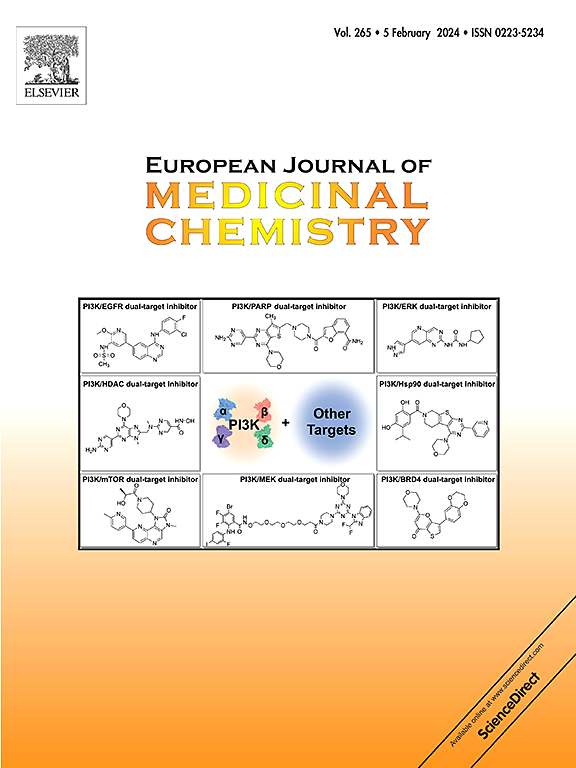SGLT2 inhibitors in translational medicine: A paradigm shift for diabetes and heart health
IF 5.9
2区 医学
Q1 CHEMISTRY, MEDICINAL
引用次数: 0
Abstract
Diabetes mellitus (DM) is a major contributor to a number of catastrophic health disorders, including heart attacks, strokes, kidney failure, blindness, and lower limb amputations. In 2023, DM was recognized by the World Health Organization (WHO) as a major cause of death. Diabetes is becoming more and more common, and any family member could be impacted. Due to the limited availability of current antidiabetic drugs, the urgent need for new active pharmaceutical ingredients becomes clear. In recent decades, sodium-glucose cotransporter-2 (SGLT2) has drawn interest as a key target for type 2 diabetes treatment. This is attributed to its innovative mechanism of action, which works independently of the insulin signalling pathway. Gliflozines, which mainly function as SGLT2 inhibitors, are a significant class of drugs used to treat type II diabetes. Several gliflozines have received approval from regulatory bodies like the FDA, EMA, and PMDA, and other compounds are presently undergoing advanced research and development. Phlorizin, a naturally occurring O-glucoside, serves as a starting compound from which various derivatives have been synthesized, including O-glucoside, C-glucoside, and N-glucoside derivatives. In addition to providing insights into the chemical modifications that increase the potency of SGLT2 inhibitors and their analogues, the review emphasizes the structure-activity relationship of these drugs. The collaborative efforts of researchers in the ongoing synthesis and development of SGLT2 inhibitors, as well as the progress achieved in the field so far, are also highlighted.


转化医学中的SGLT2抑制剂:糖尿病和心脏健康的范式转变
糖尿病(DM)是许多灾难性健康疾病的主要诱因,包括心脏病发作、中风、肾衰竭、失明和下肢截肢。2023年,糖尿病被世界卫生组织(WHO)认定为主要死亡原因。糖尿病正变得越来越普遍,任何家庭成员都可能受到影响。由于目前抗糖尿病药物的可用性有限,迫切需要新的活性药物成分变得清晰。近几十年来,钠-葡萄糖共转运蛋白-2 (SGLT2)作为2型糖尿病治疗的关键靶点引起了人们的兴趣。这归功于其创新的作用机制,它独立于胰岛素信号通路起作用。格列净主要作为SGLT2抑制剂,是一类用于治疗II型糖尿病的重要药物。一些格列净已获得FDA、EMA和PMDA等监管机构的批准,其他化合物目前正在进行高级研究和开发。连根茎苷是一种天然存在的o -葡萄糖苷,是合成各种衍生物的起始化合物,包括o -葡萄糖苷、c -葡萄糖苷和n -葡萄糖苷衍生物。除了提供增加SGLT2抑制剂及其类似物效力的化学修饰的见解外,该综述还强调了这些药物的结构-活性关系。报告还强调了研究人员在正在进行的SGLT2抑制剂的合成和开发中的合作努力,以及该领域迄今取得的进展。
本文章由计算机程序翻译,如有差异,请以英文原文为准。
求助全文
约1分钟内获得全文
求助全文
来源期刊
CiteScore
11.70
自引率
9.00%
发文量
863
审稿时长
29 days
期刊介绍:
The European Journal of Medicinal Chemistry is a global journal that publishes studies on all aspects of medicinal chemistry. It provides a medium for publication of original papers and also welcomes critical review papers.
A typical paper would report on the organic synthesis, characterization and pharmacological evaluation of compounds. Other topics of interest are drug design, QSAR, molecular modeling, drug-receptor interactions, molecular aspects of drug metabolism, prodrug synthesis and drug targeting. The journal expects manuscripts to present the rational for a study, provide insight into the design of compounds or understanding of mechanism, or clarify the targets.

 求助内容:
求助内容: 应助结果提醒方式:
应助结果提醒方式:


